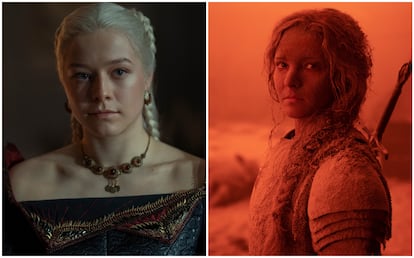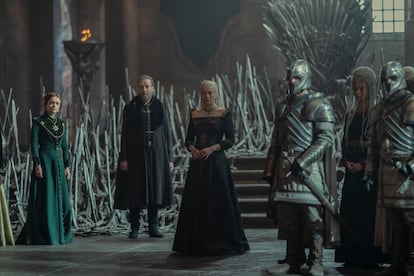
‘Rings of Power’ vs ‘House of the Dragon’: Which show is winning the popularity battle?
Audience and social media data give a sense of the results of the confrontation between the two epic fantasies
It wasn’t a battle, but it was. It wasn’t, because there didn’t have to be a victor and a loser – both could have triumphed (and lost). But the simultaneous release of House of the Dragon and The Lord of the Rings: The Rings of Power inevitably pitted them against one another. Now that the voyages back to Middle Earth and to Westeros have ended, and the first seasons are over, which has won in terms of popularity.
Though both have been undisputed hits on their respective platforms, as HBO and Amazon Prime Video have expressed in official statements, information about the two shows’ success has appeared more like marketing copy than real data. On October 25, after the end of the first season of House of the Dragon, HBO Max claimed in a press release that the series is now the most-seen title among HBO’s on-demand offerings in Spain, ahead of the last season of Game of Thrones. On the one hand, that’s logical given that the platform probably has more viewers than it did when Game of Thrones was first released. But on the other hand, just how many viewers are we talking about? The document offered more vague achievements: the show reached “the largest audience for any new original series in the history of HBO. The premiere also marked the largest series launch on HBO Max across the US, LatAm, and EMEA, driving an unprecedented level of concurrent streams on the platform.” It did include one statistic: the 10 episodes reached 29 million viewers in the United States between cable and streaming. The number is close to the 33 million that the penultimate season of Game of Thrones garnered, as Vulture points out. HBO has not specified the number of views worldwide.
Prime Video also issued an official statement after the first two episodes of The Lord of the Rings: The Rings of Power were released. The platform insisted that the TV show had been watched by more than 25 million viewers around the world on its first day, “breaking all previous records, marking the biggest premiere in the history of Prime Video.” Representatives of the platform told Variety days before the end of the season that it was on its way to 100 million users. That doesn’t count those who were waiting for the show to end to start watching it, which will add a good number of views to both shows.
But beyond the data provided by the platforms, there is also the Nielsen data, which counts the number of minutes watched on television on some platforms. According to their streaming program charts, Lord of the Rings received 977 million minutes of views in the week of September 19 to 25, while House of the Dragon reached one billion minutes in the same period. The last episodes of the HBO series maintained that viewership, according to Vulture. It must be taken into account that this measurement does not include streaming on devices other than a television, nor does it count viewings on live television, which for The House of the Dragon, also broadcast in the United States on HBO, is a considerable figure – approximately a third of its viewings – making it the clear winner in audience in its country of origin.

Olivia Cooke, Rhys Ifans and Emma D'Arcy in 'House of the Dragon.'
Another interesting piece of data is that measured by the company Parrot Analytics, which focuses on the demand for a program on the internet, taking into account factors such as buzz on social networks and legal and illegal downloads. A report by the company, as quoted in the Los Angeles Times, shows that The Lord of the Rings had an average demand 30.5 times higher than that of the average American series in its first 30 days. The House of the Dragon, for its part, achieved 55 times the average demand over the same period. At certain peaks, the HBO series generated more than double the demand of Prime Video. Once again, this data serves more as an indicator of interest in the series, and the noise that is generated around it, than of the actual audience size. But it does serve to answer which has had more influence.
A Nielsen report from mid-October, published by Business Insider, showed that 68% of the audience of House of the Dragon is concentrated in the age group of 18 to 49. The Lord of the Rings has been most successful among the older public, with 71% of its audience over 35 years old (at least in the US). The Prime Video series has had serious difficulty reaching younger audiences. The two series have a mostly male audience, contrary to the typical streaming show. The report also points out that 33% of House of the Dragon viewers were also watching The Lord of the Rings, and 34% of Lord of the Rings fans were also watching House of the Dragon.

Maxim Baldry, in ‘The Lord of the Rings: The Rings of Power.’
In short, it is clear that both have been a success. We will have both shows for a while. Of course, for now we will have to wait. While The Lord of the Rings has already begun filming its second season, HBO has asked for patience: the next season of House of the Dragon will not arrive until at least 2024.


No comments:
Post a Comment